2014 MERCEDES-BENZ GL fuel pressure
[x] Cancel search: fuel pressurePage 21 of 462
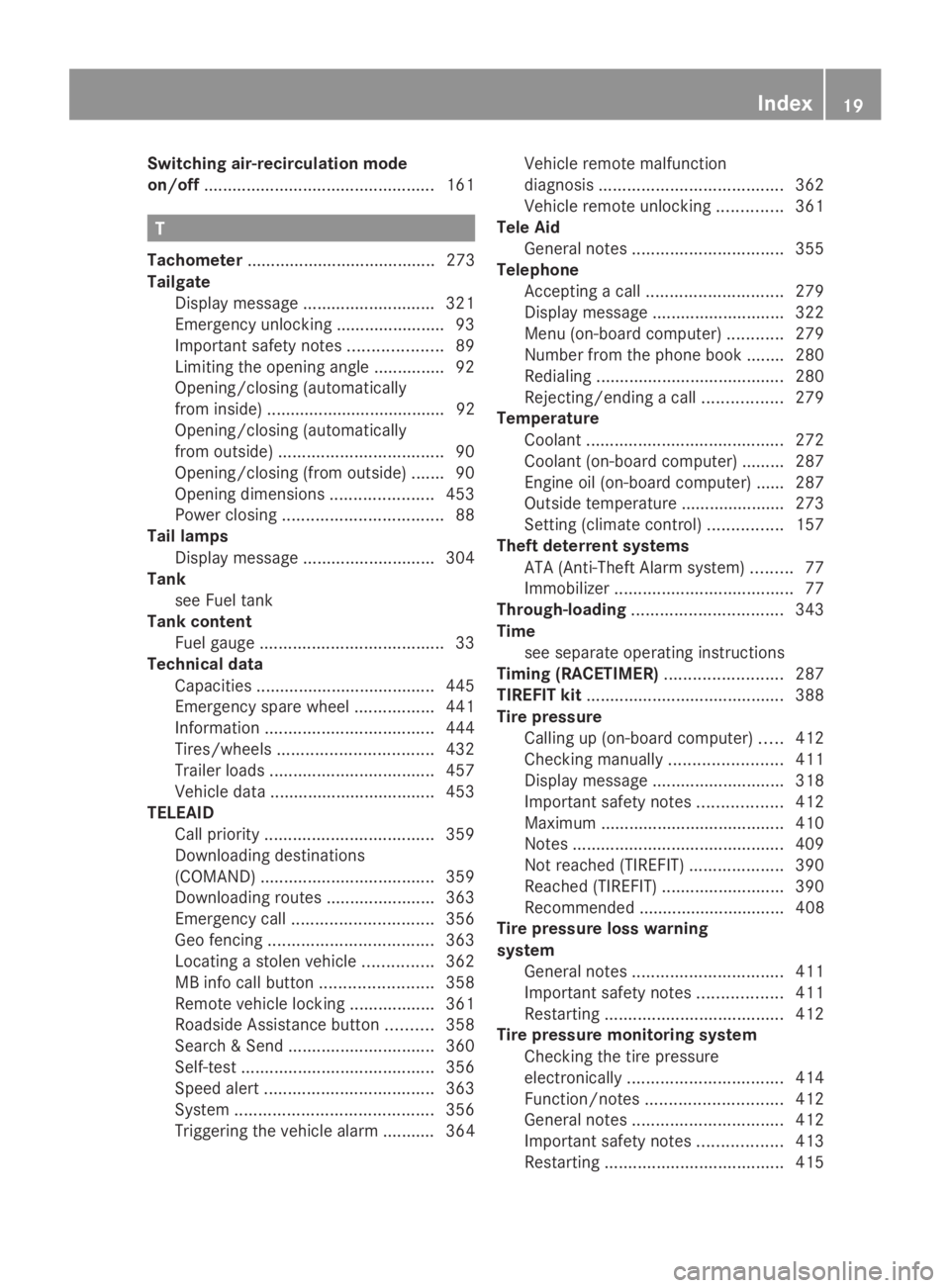
Switching air-recirculation mode
on/off.................................................161
T
Tachometer........................................ 273
Tailgate
Display message............................321
Emergency unlocking.......................93
Important safety notes....................89
Limiting the opening angle...............92
Opening/closing (automatically
from inside) ...................................... 92
Opening/closing (automatically
from outside)...................................90
Opening/closing (from outside).......90
Opening dimensions......................453
Power closing..................................88
Tail lamps
Display message............................304
Tank
see Fuel tank
Tank content
Fuel gauge.......................................33
Technical data
Capacities......................................445
Emergency spare wheel.................441
Information....................................444
Tires/wheels.................................432
Trailer loads...................................457
Vehicle data...................................453
TELEAID
Call priority....................................359
Downloading destinations
(COMAND).....................................359
Downloading routes.......................363
Emergency call..............................356
Geo fencing...................................363
Locating a stolen vehicle...............362
MB info call button........................358
Remote vehicle locking..................361
Roadside Assistance button..........358
Search & Send...............................360
Self-test.........................................356
Speed alert....................................363
System..........................................356
Triggering the vehicle alarm ........... 364
Vehicle remote malfunction
diagnosis.......................................362
Vehicle remote unlocking..............361
Tele Aid
General notes................................355
Telephone
Accepting a call.............................279
Display message............................322
Menu (on-board computer)............279
Number from the phone book ........280
Redialing........................................280
Rejecting/ending a call.................279
Temperature
Coolant..........................................272
Coolant (on-board computer) ......... 287
Engine oil (on-board computer) ...... 287
Outside temperature ......................273
Setting (climate control)................157
Theft deterrent systems
ATA (Anti-Theft Alarm system).........77
Immobilizer......................................77
Through-loading................................343
Time
see separate operating instructions
Timing (RACETIMER).........................287
TIREFIT kit..........................................388
Tire pressure
Calling up (on-board computer).....412
Checking manually........................411
Display message............................318
Important safety notes..................412
Maximum.......................................410
Notes.............................................409
Not reached (TIREFIT)....................390
Reached (TIREFIT)..........................390
Recommended ............................... 408
Tire pressure loss warning
system
General notes................................411
Important safety notes..................411
Restarting......................................412
Tire pressure monitoring system
Checking the tire pressure
electronically.................................414
Function/notes.............................412
General notes................................412
Important safety notes..................413
Restarting......................................415
Index19
Page 24 of 462
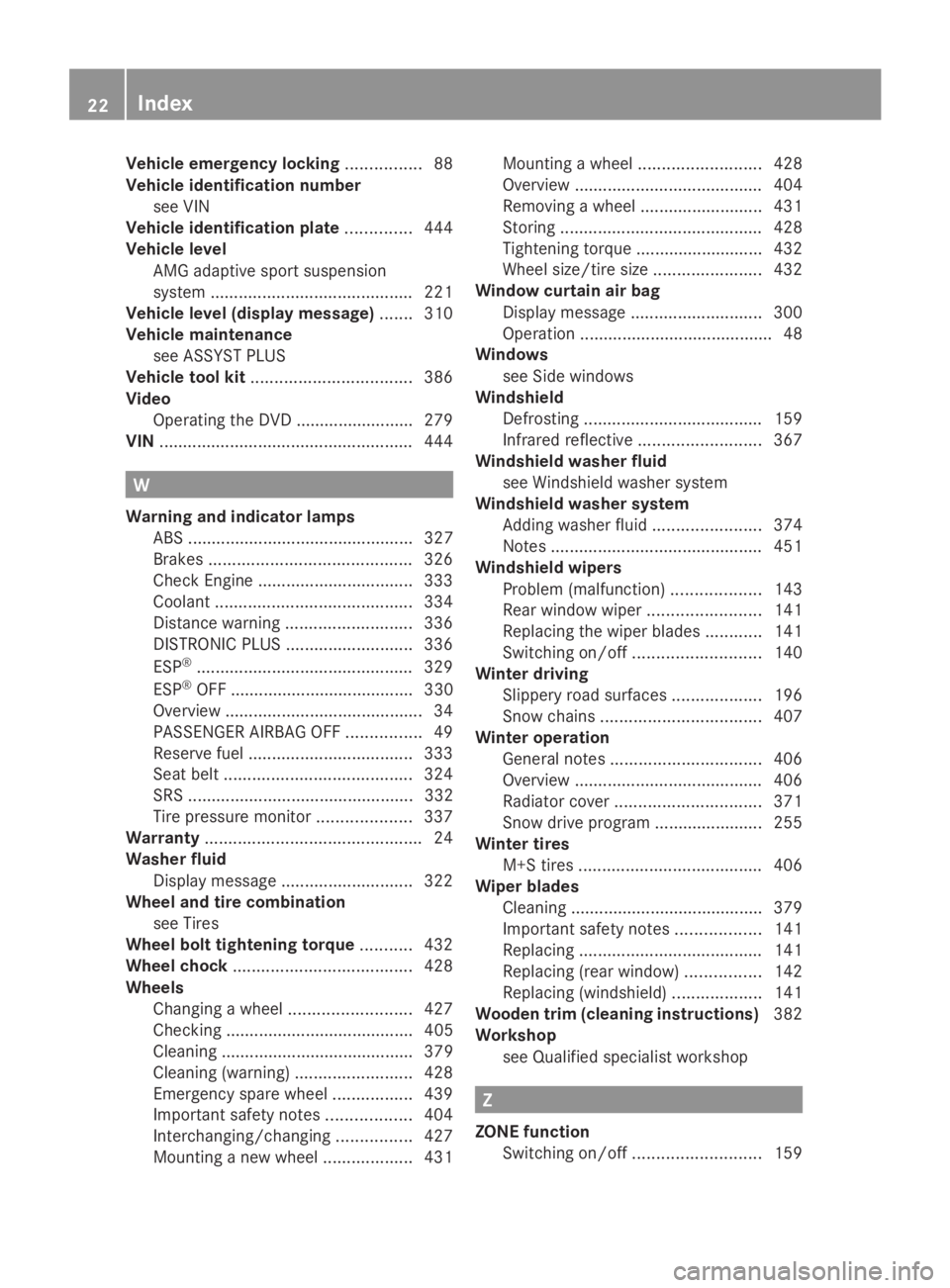
Vehicle emergency locking................88
Vehicle identification number
see VIN
Vehicle identification plate..............444
Vehicle level
AMG adaptive sport suspension
system...........................................221
Vehicle level (display message).......310
Vehicle maintenance
see ASSYST PLUS
Vehicle tool kit..................................386
Video
Operating the DVD ......................... 279
VIN......................................................444
W
Warning and indicator lamps
ABS ................................................ 327
Brakes...........................................326
Check Engine.................................333
Coolant..........................................334
Distance warning...........................336
DISTRONIC PLUS...........................336
ESP®..............................................329
ESP®OFF ....................................... 330
Overview..........................................34
PASSENGER AIRBAG OFF................49
Reserve fuel...................................333
Seat belt........................................324
SRS ................................................ 332
Tire pressure monitor....................337
Warranty..............................................24
Washer fluid
Display message............................322
Wheel and tire combination
see Tires
Wheel bolt tightening torque...........432
Wheel chock......................................428
Wheels
Changing a wheel..........................427
Checking ........................................ 405
Cleaning ......................................... 379
Cleaning (warning).........................428
Emergency spare wheel.................439
Important safety notes..................404
Interchanging/changing................427
Mounting a new wheel...................431
Mounting a wheel..........................428
Overview........................................404
Removing a wheel..........................431
Storing...........................................428
Tightening torque ........................... 432
Wheel size/tire size.......................432
Window curtain air bag
Display message............................300
Operation .........................................48
Windows
see Side windows
Windshield
Defrosting......................................159
Infrared reflective..........................367
Windshield washer fluid
see Windshield washer system
Windshield washer system
Adding washer fluid.......................374
Notes.............................................451
Windshield wipers
Problem (malfunction)...................143
Rear window wiper........................141
Replacing the wiper blades............141
Switching on/off...........................140
Winter driving
Slippery road surfaces...................196
Snow chains..................................407
Winter operation
General notes................................406
Overview........................................406
Radiator cover...............................371
Snow drive program ....................... 255
Winter tires
M+S tires.......................................406
Wiper blades
Cleaning ......................................... 379
Important safety notes..................141
Replacing.......................................141
Replacing (rear window)................142
Replacing (windshield)...................141
Wooden trim (cleaning instructions)382
Workshop
see Qualified specialist workshop
Z
ZONE function
Switching on/off...........................159
22Index
Page 25 of 462

Protection of the environment
General notes
HEnvironmental note
Daimler's declared policy is one of
comprehensive environmental protection.
The objectives are for the natural resources
that form the basis of our existence on this
planet to be used sparingly and in a manner
that takes the requirements of both nature
and humanity into account.
You too can help to protect the environment
by operating your vehicle in an
environmentally responsible manner.
Fuel consumption and the rate of engine,
transmission, brake and tire wear are affected
by these factors:
Roperating conditions of your vehicle
Ryour personal driving style
You can influence both factors. You should
bear the following in mind:
Operating conditions:
Ravoid short trips as these increase fuel
consumption.
Ralways make sure that the tire pressures
are correct.
Rdo not carry any unnecessary weight.
Rremove roof racks once you no longer need
them.
Ra regularly serviced vehicle will contribute
to environmental protection. You should
therefore adhere to the service intervals.
Ralways have service work carried out at a
qualified specialist workshop.
Personal driving style:
Rdo not depress the accelerator pedal when
starting the engine.
Rdo not warm up the engine when the vehicle
is stationary.
Rdrive carefully and maintain a safe distance
from the vehicle in front.
Ravoid frequent, sudden acceleration and
braking.
Rchange gear in good time and use each gear
only up to�
Page 182 of 462

XAMG vehicles:press the program selector
button (Ypage 177) untilMappears in the
multifunction display.
XVehicles with the ON&OFFROAD
package:press the program selector
button (Ypage 177).
The letterMappears in the multifunction
display.
Shifting up (all vehicles except AMG
vehicles)
XIf corresponding gearshift
recommendation�Cappears in the
multifunction display on the instrument
cluster, pull on the right-hand steering
wheel paddle shifter (Ypage 177).
The automatic transmission shifts to
recommended gear�D.
Shifting up (AMG vehicles)
!In manual drive programM, the automatic
transmission does not shift up
automatically even when the engine
limiting speed for the current gear is
reached. When the engine limiting speed is
reached, the fuel supply is cut to prevent
the engine from overrevving. Always make
sure that the engine speed does not reach
the red area of the tachometer. There is
otherwise a risk of engine damage.
�CGear indicator
�DUpshift indicator
Before the engine speed reaches the red area,
an upshift indicator will be shown in the
multifunction display.
XIf the color in the speedometer
multifunction display changes to red and
theUPUPdisplay message is shown, shift up
a gear.
Downshifting
XPull the left-hand steering wheel paddle
shifter (Ypage 177).
The automatic transmission shifts down to
the next gear.
Maximum acceleration
XPull the left-hand steering wheel paddle
shifter until the transmission selects the
optimum gear according to the speed.
iIf you slow down or stop without shifting
down, the automatic transmission
automatically shifts down.
Kickdown
You can also use kickdown for maximum
acceleration in manual drive programM.
XDepress the accelerator pedal beyond the
pressure point.
The automatic transmission shifts to a
lower gear depending on the engine speed.
XShift back up once the desired speed is
reached.
iAll vehicles (except AMG vehicles):if
you apply full throttle, the automatic
transmission shifts up to the next gear
when the maximum engine speed is
180Automatic transmission
Driving and pa rking
Page 194 of 462
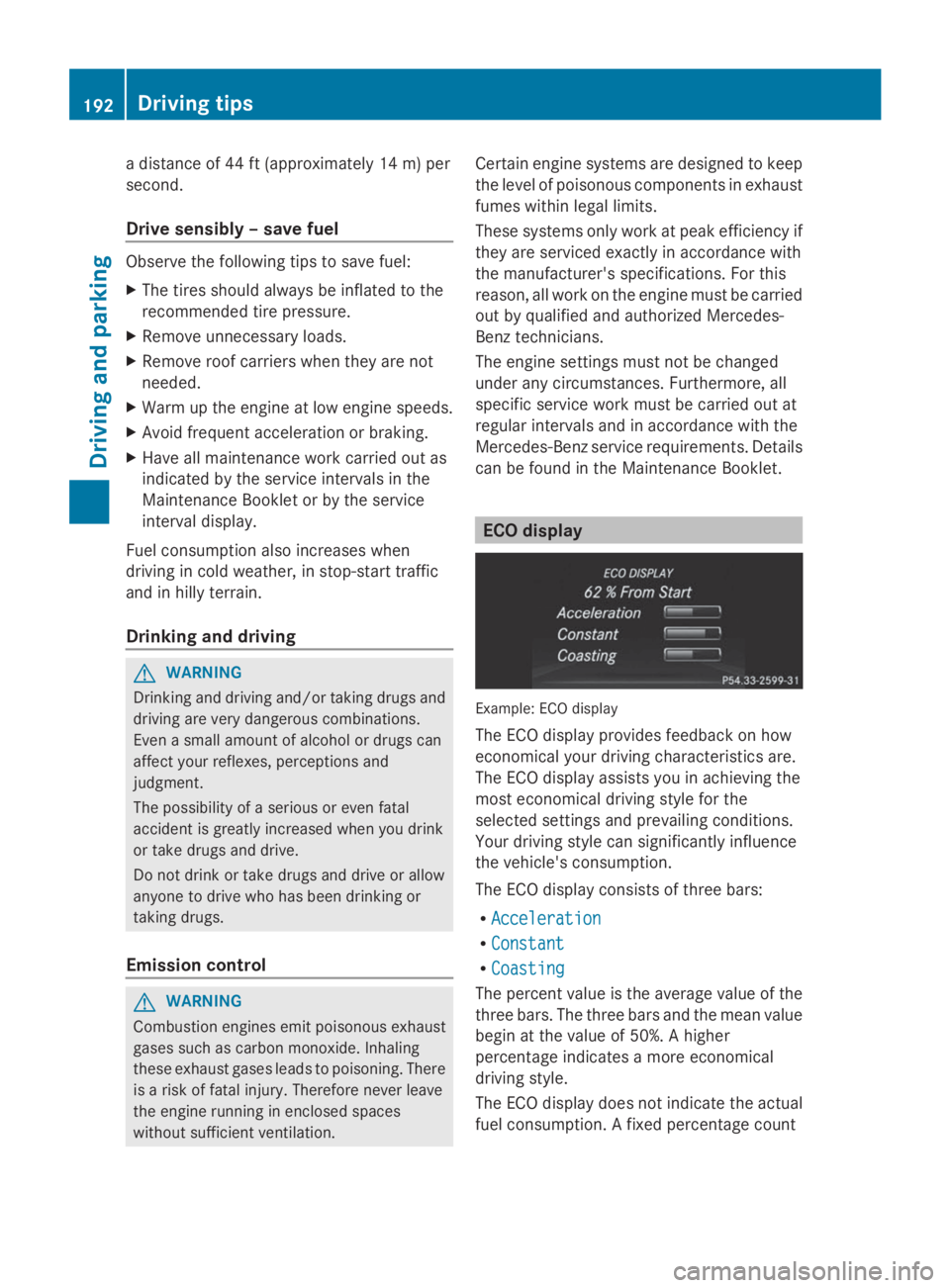
a distance of 44 ft (approximately 14 m) per
second.
Drive sensibly – save fuel
Observe the following tips to save fuel:
XThe tires should always be inflated to the
recommended tire pressure.
XRemove unnecessary loads.
XRemove roof carriers when they are not
needed.
XWarm up the engine at low engine speeds.
XAvoid frequent acceleration or braking.
XHave all maintenance work carried out as
indicated by the service intervals in the
Maintenance Booklet or by the service
interval display.
Fuel consumption also increases when
driving in cold weather, in stop-start traffic
and in hilly terrain.
Drinking and driving
GWARNING
Drinking and driving and/or taking drugs and
driving are very dangerous combinations.
Even a small amount of alcohol or drugs can
affect your reflexes, perceptions and
judgment.
The possibility of a serious or even fatal
accident is greatly increased when you drink
or take drugs and drive.
Do not drink or take drugs and drive or allow
anyone to drive who has been drinking or
taking drugs.
Emission control
GWARNING
Combustion engines emit poisonous exhaust
gases such as carbon monoxide. Inhaling
these exhaust gases leads to poisoning. There
is a risk of fatal injury. Therefore never leave
the engine running in enclosed spaces
without sufficient ventilation.
Certain engine systems are designed to keep
the level of poisonous components in exhaust
fumes within legal limits.
These systems only work at peak efficiency if
they are serviced exactly in accordance with
the manufacturer's specifications. For this
reason, all work on the engine must be carried
out by qualified and authorized Mercedes-
Benz technicians.
The engine settings must not be changed
under any circumstances. Furthermore, all
specific service work must be carried out at
regular intervals and in accordance with the
Mercedes-Benz service requirements. Details
can be found in the Maintenance Booklet.
ECO display
Example: ECO display
The ECO display provides feedback on how
economical your driving characteristics are.
The ECO display assists you in achieving the
most economical driving style for the
selected settings and prevailing conditions.
Your driving style can significantly influence
the vehicle's consumption.
The ECO display consists of three bars:
RAccelerationAcceleration
RConstantConstant
RCoastingCoasting
The percent value is the average value of the
three bars. The three bars and the mean value
begin at the value of 50%. A higher
percentage indicates a more economical
driving style.
The ECO display does not indicate the actual
fuel consumption. A fixed percentage count
192Driving tips
Driving and parking
Page 266 of 462
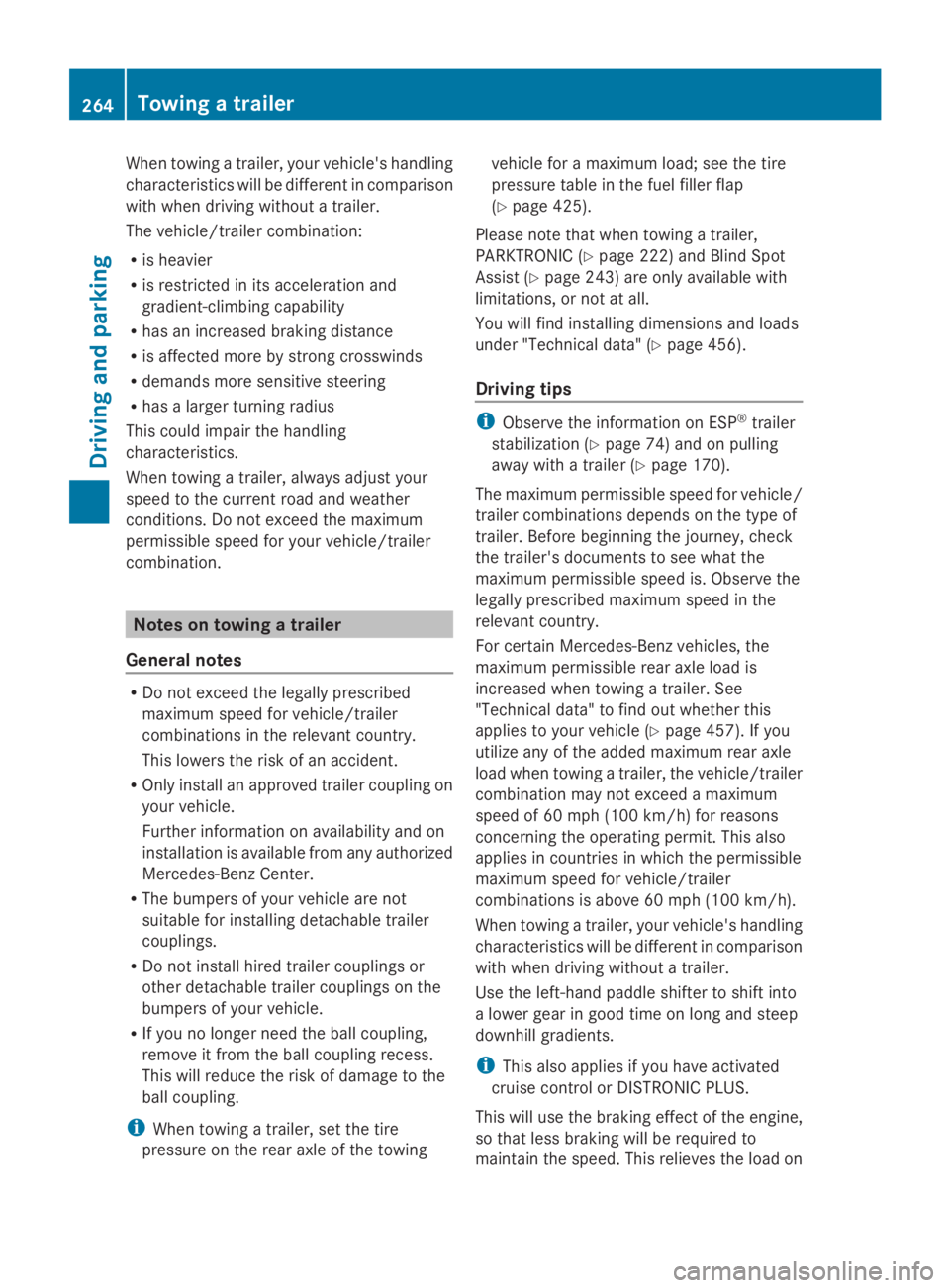
When towing a trailer, your vehicle's handling
characteristics will be different in comparison
with when driving without a trailer.
The vehicle/trailer combination:
Ris heavier
Ris restricted in its acceleration and
gradient-climbing capability
Rhas an increased braking distance
Ris affected more by strong crosswinds
Rdemands more sensitive steering
Rhas a larger turning radius
This could impair the handling
characteristics.
When towing a trailer, always adjust your
speed to the current road and weather
conditions. Do not exceed the maximum
permissible speed for your vehicle/trailer
combination.
Notes on towing a trailer
General notes
RDo not exceed the legally prescribed
maximum speed for vehicle/trailer
combinations in the relevant country.
This lowers the risk of an accident.
ROnly install an approved trailer coupling on
your vehicle.
Further information on availability and on
installation is available from any authorized
Mercedes-Benz Center.
RThe bumpers of your vehicle are not
suitable for installing detachable trailer
couplings.
RDo not install hired trailer couplings or
other detachable trailer couplings on the
bumpers of your vehicle.
RIf you no longer need the ball coupling,
remove it from the ball coupling recess.
This will reduce the risk of damage to the
ball coupling.
iWhen towing a trailer, set the tire
pressure on the rear axle of the towing
vehicle for a maximum load; see the tire
pressure table in the fuel filler flap
(Ypage 425).
Please note that when towing a trailer,
PARKTRONIC (Ypage 222) and Blind Spot
Assist (Ypage 243) are only available with
limitations, or not at all.
You will find installing dimensions and loads
under "Technical data" (Ypage 456).
Driving tips
iObserve the information on ESP®trailer
stabilization (Ypage 74) and on pulling
away with a trailer (Ypage 170).
The maximum permissible speed for vehicle/
trailer combinations depends on the type of
trailer. Before beginning the journey, check
the trailer's documents to see what the
maximum permissible speed is. Observe the
legally prescribed maximum speed in the
relevant country.
For certain Mercedes-Benz vehicles, the
maximum permissible rear axle load is
increased when towing a trailer. See
"Technical data" to find out whether this
applies to your vehicle (Ypage 457). If you
utilize any of the added maximum rear axle
load when towing a trailer, the vehicle/trailer
combination may not exceed a maximum
speed of 60 mph (100 km/h) for reasons
concerning the operating permit. This also
applies in countries in which the permissible
maximum speed for vehicle/trailer
combinations is above 60 mph (100 km/h).
When towing a trailer, your vehicle's handling
characteristics will be different in comparison
with when driving without a trailer.
Use the left-hand paddle shifter to shift into
a lower gear in good time on long and steep
downhill gradients.
iThis also applies if you have activated
cruise control or DISTRONIC PLUS.
This will use the braking effect of the engine,
so that less braking will be required to
maintain the speed. This relieves the load on
264Towing a trailer
Driving and parking
Page 393 of 462
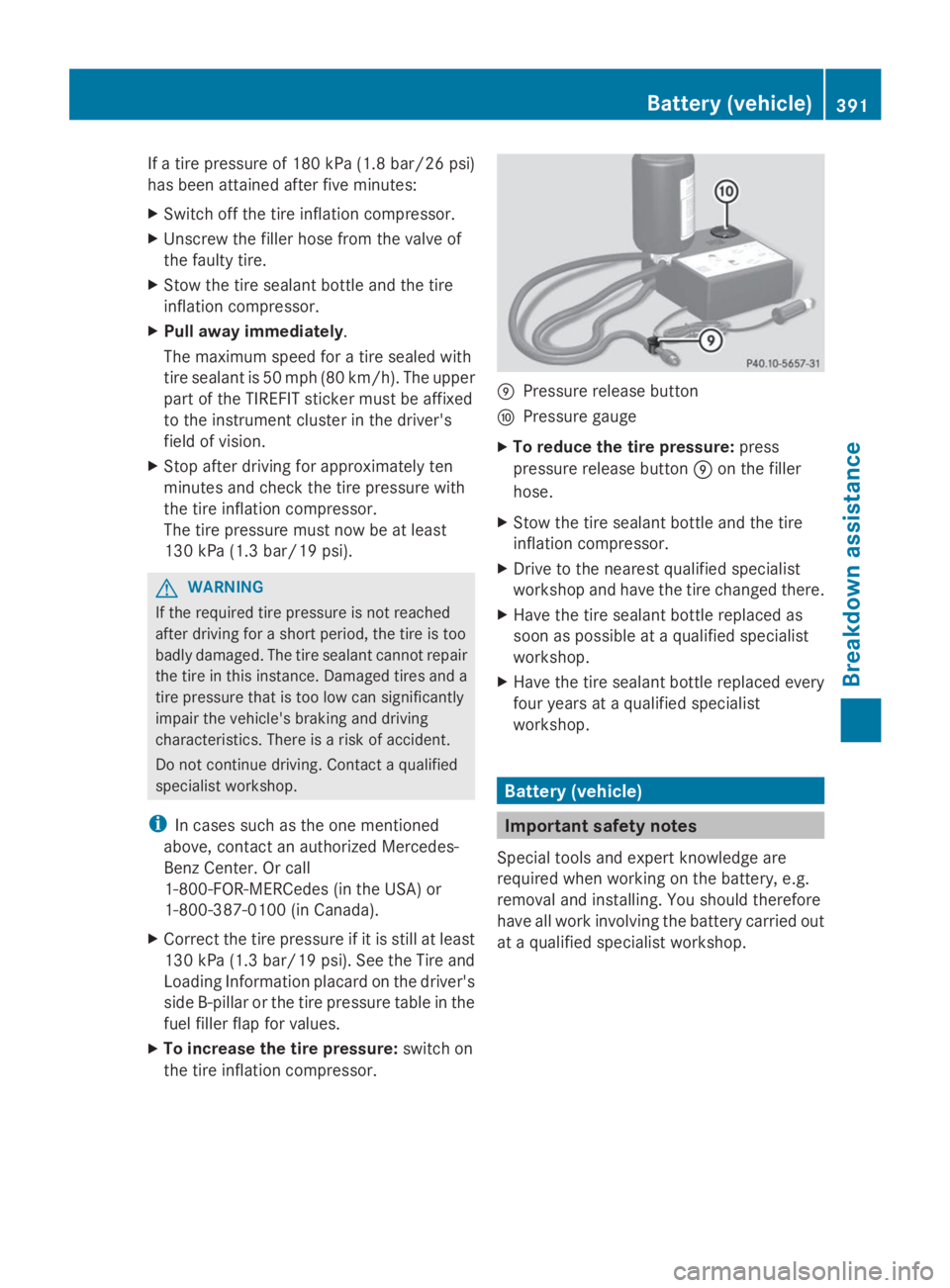
If a tire pressure of 180 kPa(1.8 bar/26 psi)
has been attained after five minutes:
XSwitch off the tire inflation compressor.
XUnscrew the filler hose from the valve of
the faulty tire.
XStow the tire sealant bottle and the tire
inflation compressor.
XPull away immediately.
The maximum speed for a tire sealed with
tire sealant is 50 mph (80 km/h). The upper
part of the TIREFIT sticker must be affixed
to the instrument cluster in the driver's
field of vision.
XStop after driving for approximately ten
minutes and check the tire pressure with
the tire inflation compressor.
The tire pressure must now be at least
130 kPa (1.3 bar/19 psi).
GWARNING
If the required tire pressure is not reached
after driving for a short period, the tire is too
badly damaged. The tire sealant cannot repair
the tire in this instance. Damaged tires and a
tire pressure that is too low can significantly
impair the vehicle's braking and driving
characteristics. There is a risk of accident.
Do not continue driving. Contact a qualified
specialist workshop.
iIn cases such as the one mentioned
above, contact an authorized Mercedes-
Benz Center. Or call
1-800-FOR-MERCedes (in the USA) or
1-800-387-0100 (in Canada).
XCorrect the tire pressure if it is still at least
130 kPa(1.3 bar/19 psi). See the Tire and
Loading Information placard on the driver's
side B-pillaror the tire pressure table in the
fuel filler flap for values.
XTo increase the tire pressure:switch on
the tire inflation compressor.
�mPressure release button
�nPressure gauge
XTo reduce the tire pressure:press
pressure release button�mon the filler
hose.
XStow the tire sealant bottle and the tire
inflation compressor.
XDrive to the nearest qualified specialist
workshop and have the tire changed there.
XHave the tire sealant bottle replaced as
soon as possible at a qualified specialist
workshop.
XHave the tire sealant bottle replaced every
four years at a qualified specialist
workshop.
Battery (vehicle)
Important safety notes
Special tools and expert knowledge are
required when working on the battery, e.g.
removal and installing. You should therefore
have all work involving the battery carried out
at a qualified specialist workshop.
Battery (vehicle)391
Breakdown assistance
Z
Page 406 of 462
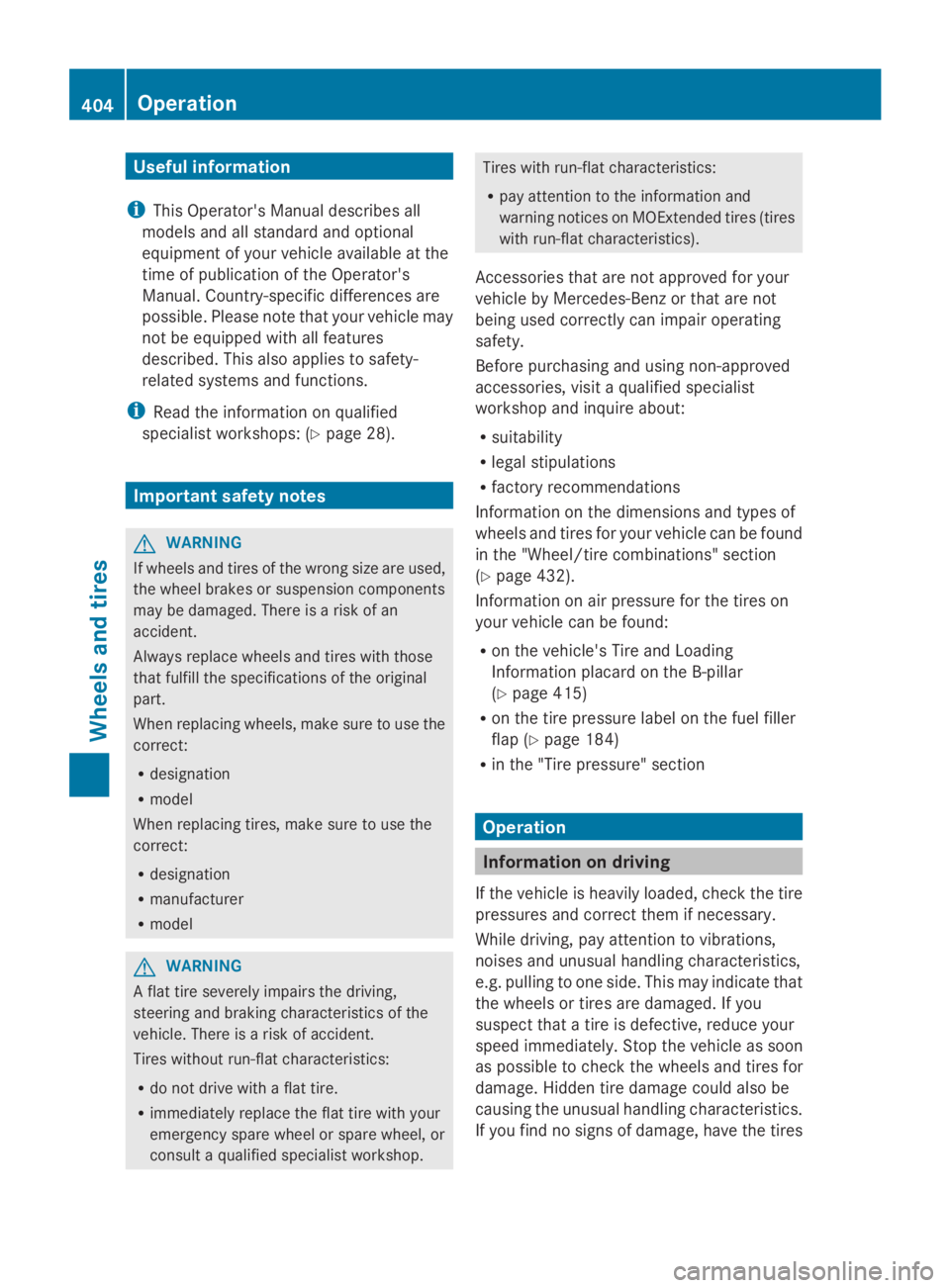
Useful information
iThis Operator's Manual describes all
models and all standard and optional
equipment of your vehicle available at the
time of publication of the Operator's
Manual. Country-specific differences are
possible. Please note that your vehicle may
not be equipped with all features
described. This also applies to safety-
related systems and functions.
iRead the information on qualified
specialist workshops: (Ypage 28).
Important safety notes
GWARNING
If wheels and tires of the wrong size are used,
the wheel brakes or suspension components
may be damaged. There is a risk of an
accident.
Always replace wheels and tires with those
that fulfill the specifications of the original
part.
When replacing wheels, make sure to use the
correct:
Rdesignation
Rmodel
When replacing tires, make sure to use the
correct:
Rdesignation
Rmanufacturer
Rmodel
GWARNING
A flat tire severely impairs the driving,
steering and braking characteristics of the
vehicle. There is a risk of accident.
Tires without run-flat characteristics:
Rdo not drive with a flat tire.
Rimmediately replace the flat tire with your
emergency spare wheel or spare wheel, or
consult a qualified specialist workshop.
Tires with run-flat characteristics:
Rpay attention to the information and
warning notices on MOExtended tires (tires
with run-flat characteristics).
Accessories that are not approved for your
vehicle by Mercedes-Benz or that are not
being used correctly can impair operating
safety.
Before purchasing and using non-approved
accessories, visit a qualified specialist
workshop and inquire about:
Rsuitability
Rlegal stipulations
Rfactory recommendations
Information on the dimensions and types of
wheels and tires for your vehicle can be found
in the "Wheel/tire combinations" section
(Ypage 432).
Information on air pressure for the tires on
your vehicle can be found:
Ron the vehicle's Tire and Loading
Information placard on the B-pillar
(Ypage 415)
Ron the tire pressure label on the fuel filler
flap (Ypage 184)
Rin the "Tire pressure" section
Operation
Information on driving
If the vehicle is heavily loaded, check the tire
pressures and correct them if necessary.
While driving, pay attention to vibrations,
noises and unusual handling characteristics,
e.g. pulling to one side. This may indicate that
the wheels or tires are damaged. If you
suspect that a tire is defective, reduce your
speed immediately. Stop the vehicle as soon
as possible to check the wheels and tires for
damage. Hidden tire damage could also be
causing the unusual handling characteristics.
If you find no signs of damage, have the tires
404Operation
Wheels and tires